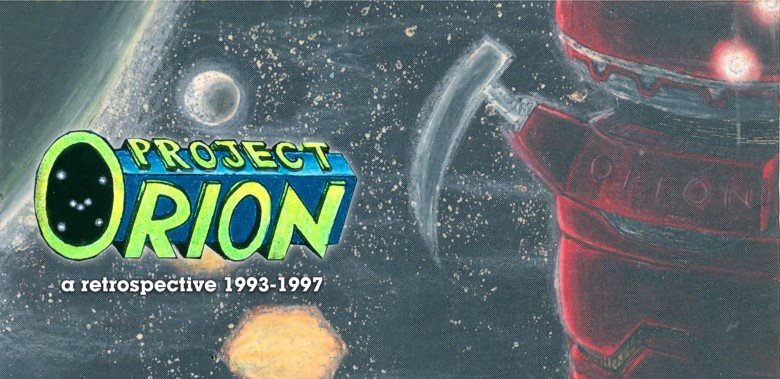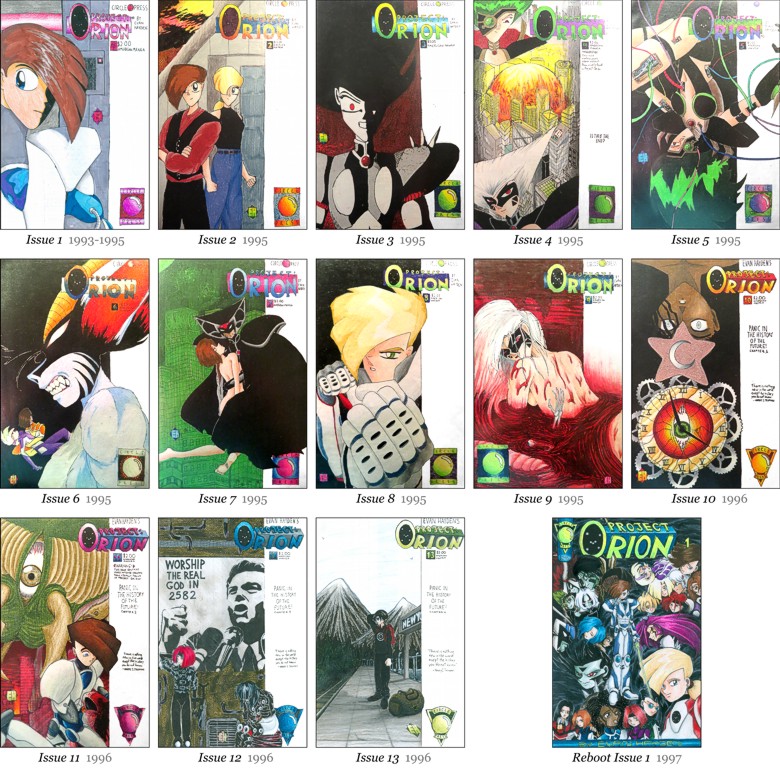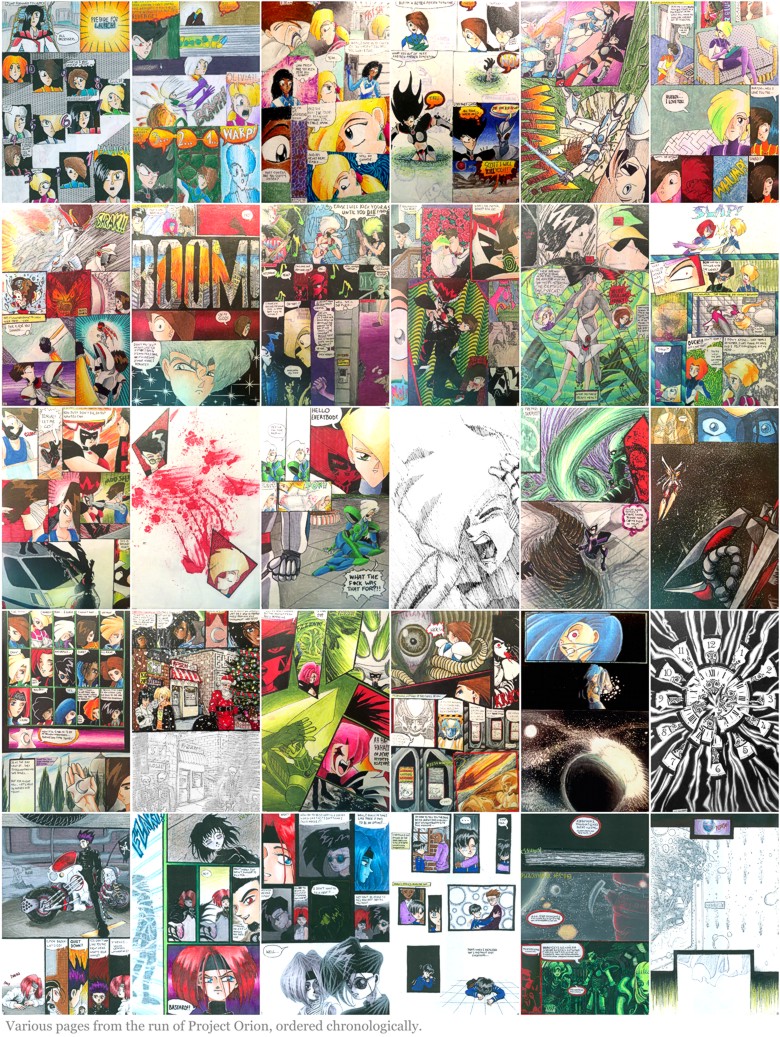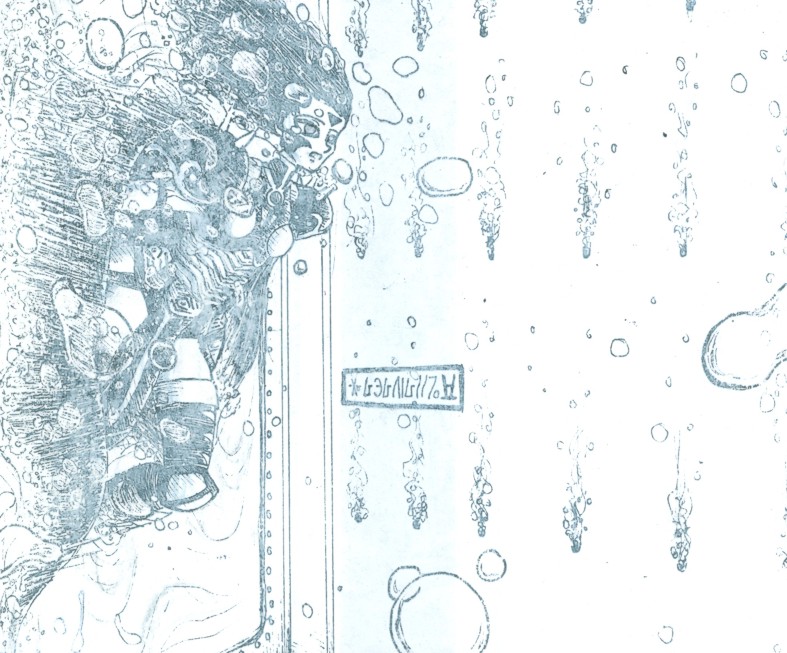
(I meant to make this post on July 15th 2016, a special day, but life got crazy-busy. Oh well, better late than never. I’ll explain the significance of that date soon enough.) (Also, in case you’re reading this several years later, something broke in my WordPress files and it’s jamming all the paragraphs together. Sorry if it’s a little hard to read because of that. I’ll fix it when I have time. )
When I was in middle school and high school, I used to draw a ton of comics. I’d usually crank out an issue per month, full-color, and sometimes two. I started several series, all of which were seen by only friends and family, and the occasional comic artist I was getting a portfolio review from. I had big dreams of exploding upon the comics world as soon as I graduated and finding a spot in said world for my manga-influenced comics – a sort of rare thing in the states, in the mid-90s. Various things eventually kept this from happening… the realities of life… I started college and didn’t have time to make comics. My interest in photography became a full-on passion and pushed the comics aside and I took on new hobbies like making music. I started having a social life in high school, and later in college at techno & house music nights. I started enjoying dating girls as opposed to just wishing I could be less awkward and shy. …aaaand my confidence in my artistic abilities and ability to network waned, but let’s keep this post positive. Anyway, let’s rewind…
I started drawing comics in 1991, when I was 11 years old, and began by just drawing a lot of pictures of Spider-Man and other superheroes. I made my first original character, “Electron Man”, and messed around with drawings of him fighting crime, but never really made any actual comics with him. I read superhero comics religiously during that time. I had been given a lot of superhero comics as a really young kid (like 4-5) as well, but I mostly scribbled in them. As an all-grown-up 11 year old, I devoured issues of Todd McFarlane & Erik Larsen’s runs on Amazing Spider-Man (and eponymous Spider-Man), Jim Lee’s X-Men run, and other early ’90s contemporary superhero books, and then delved back further into back-issues from the ’70s and ’80s, reading a lot of John Byrne Uncanny X-Men, as well as less popular, weird, awesome comics like Cloak & Dagger, Dazzler, ROM, New Mutants, and Moon Knight. I also was reading a lot of “mature readers” stuff that thankfully my mom knew I was mature enough for, like a lot of Vertigo stuff, Swamp Thing, Sandman, Preacher, and other more mature stuff like Matt Wagner’s amazing Grendel and Sam Keith’s The Maxx.
In 1993, I picked up a copy of Battle Angel Alita #1, and instantly became a fan of Japanese comics. Around this same time, I was watching my brother’s old Robotech VHS tapes, and then realized – via an ad in Battle Angel for said manga’s anime adaptation – that there was a whole world of Japanese animation to explore. Thus began my otaku days. Back then the only way to get anime in the US was on outrageously-overpriced VHS tapes, where in order to collect a series like, say, Ranma 1/2, you’d have to shell out $30 each for a bunch of two-episode tapes. I would get some of my anime this way, and some via bootleg fansubs of Japan-only titles that I would pick up at conventions. As for manga, that’s when companies like Viz and Dark Horse were still releasing thin floppy US-style releases, where you’d get one chapter, and then have to wait a month for the next one, and eventually be able to get it in a collection. Manga was flipped to read Western-style, and the sound effects were totally replaced. Also, many manga being released in the states involved actual ink-based lettering, as opposed to the comic-friendly fonts we have access to now. (In my current job as a manga letterer – jumping a head a moment here – it already takes crazy-long to do each tankoban volume I work on, and I can’t imagine how much longer it took to do it all in ink!) There are so many titles that brought me so much joy throughout middle school and high school… Akira, Ranma 1/2, Maison Ikkoku, Urusei Yatsura, Macross, Mai the Psychic Girl, Crying Freeman, Cutey Honey, Devilman, Caravan Kidd, Dominion Tank Police, Ghost in the Shell, Dirty Pair, Lupin the Third, Baoh, Xenon, and last but certainly not least, anything by Osamu Tezuka!
In those early days, I started a comic that was very inspired by all the manga and anime I was taking in. I called it “Project Orion”

It was a space opera, very much inspired predominantly by Macross / Robotech, and by Star Trek TNG. I also worked in inspiration from Akira, Ghost in the Shell, Battle Angel, Chrono Trigger, and Go Nagai anime. “Worked in inspiration” might be a generous way to word it. Looking back on the comic years later, I basically copied a lot of stuff from those inspirations, but I suppose that’s to be expected when you’re an adolescent. Art doesn’t come from a vacuum after all, and when you’re learning how to draw and craft stories, it’s a good idea to take ideas from things that interest you, and reshape them to fit your vision. It took me over a year to make the first issue, because I just didn’t have the work habits for it yet. After that, I cranked out monthly 22 page issues until my later high school years.
So why is July 15th 2016 a special day for me? Well, that’s the date where the story begins, when the big space station launches from Earth. When I was a kid, 2016 seemed like an impossibly futuristic time – a time where it wouldn’t be unreasonable to imagine things like warp-drive, teleportation, transformable mecha, contact with aliens, and the world’s governments allocating as many resources to space exploration as the real 2016 allocates to warfare and corporations. Back then, twenty years seemed like an epoch of major size, and yet, twenty years since then, it feels like it flashed away in a second. The me of today doesn’t have much confidence that we’ll be doing much in space in 2036. We’ll probably be more isolated from each other than ever thanks to the trends of our “social” technologies, meanwhile fighting over resources and trying to fend off the ravages of climate change here on Earth. But I digress… The story revolved around a group of teenagers picked to travel on this giant spacecraft and see what the outer reaches of our galaxy holds. (Of course it’s teenagers. It’s always teenagers. Maybe if I were doing the comic now, it’d be a bunch of flabby disillusioned 30-somethings. Art reflects life.) Anyway, this peaceful mission doesn’t stay peaceful for long, as they are ambushed by space pirate aliens. The first story arc, issues 1-9, mostly focused on the story of dealing with them, with themes of revenge, and overcoming the urge for said revenge. The villains became a bit more sympathetic over time, as a younger member of their group falls in love with one of the human characters, and a new villain is introduced who is intent on wiping out this band of space pirates and their entire species. The story of this genocide would take place in the background during the second story arc…

I was feeling heavily influenced by the SNES game Chrono Trigger, I made issue 10 the start of a time travel story arc. It was to be much longer and varied than the first arc. Around this time I decided to reinvent my art style, and started drawing characters with a little bit smaller eyes and less bizarre face shapes. (Masakazu Katsura and his Video Girl Ai and DNA2 series were a big art style inspiration on me at the time) Anyway, in this first issue, one of the characters discovers a stone that teleports her to a mysterious dimension where she meets a pantheon of space gods. She is instructed that stones like this grant the power of at-will time travel and teleportation. Our space explorers are each given one of these stones, and instructed to use them with the guidance of the god of time, in order to right wrongs and seek knowledge. Two of the characters, a brother and sister, play a little loose with the timeline and save their parents from the car accident that killed them. Another character travels a few days into the future, to Christmas 2016, to walk around Central Park and enjoy the lights and snow. She then witnesses something terrible – the total destruction of New York. She and the other characters learn that in a few short days, the Earth will be ravaged by an alien being that feeds off of planets, moving from one world to the next. (This alien being, “Anuo”, was admittedly quite inspired by Chrono Trigger’s “Lavos”) The team of the Orion are tasked with using their best technology and training to try to defeat Anuo, but they are slaughtered in quick succession. They are reincarnated by the gods and told that they must learn more before they can defeat the beast. The god of time then casts the thirteen main characters into wildly different time periods and locations, without the immediate aid of their time stones. They have to find their stones in whatever ways they can, in order to return back to modern day. I only managed to do two of the characters’ solo stories – one girl was thrown into a post-Anuo dystopian future in an underwater city, and one guy was cast into ancient Egypt. I had planned lots of other interesting settings… World War II Germany from the sides of two lovers, one a Jewish girl cast right into the fray, and one, her boyfriend who landed there 40 years earlier and never found his stone. I also had a samurai story in Japan… a wayyyyy distant future story… a western… an ’80s Los Angeles story… and lots of good stuff planned…. Then I rebooted the series from scratch.
I started the reboot in 1997. I felt the need to reboot since a lot of the story was based off of things that I started to realize were carbon copies of plot elements of different anime. I wanted to make a more truly original story, using the same characters, redesigned to be a little less ridiculous… some of the original designs had absolutely dumb hairstyles and inane personalities, and some were the products of my puberty-addled brain, which in my high school years was starting to embarrass me (let’s just say that the redesigned females had more realistic proportions). I rewrote the history of the characters, planned out more distinct personalities, erased things that originally caused gaping plot holes and trimmed the fat. I also planned a new pacing that would take things in a more deliberate and detailed fashion, as I realized that my original series had a lot of shortcuts and places where I didn’t feel like drawing scenes out, so things jumped all over the place. I had big plans to retell the general story arcs that I’d worked on, but from new angles and with new plot devices that came from lots of thought and advice from my family and friends… I also had plans for a big third arc which would wrap up the story of the original crew, helping their alien former-foes escape genocide, and then a sequel focusing on the children of the original characters, dealing with sentient technology gone awry and, then even further on, a second sequel that would be set a couple hundred years in the future, after said gone-awry-tech basically brought an end to man’s space exploration as it was once known. Big plans…. but I only made a few pages of that reboot issue 1, and soon got too busy with friends, love life, and homework, to continue.

After that, I had some false starts on other comics, including a cyberpunk police drama in the vein of Ghost in the Shell (called “Neo Necropolis”), and then a story about an American foreign exchange student in Japan (“Tokyo Jack”). Neither made it past a few pages. College changed me in a lot of ways, and as I was growing jaded about a lot of anime, my interest in making comics inspired by it also waned. There are times where I wish I could go back to those young days of making lots and lots of comics, but in retrospect, it was a simultaneously happy and sad time. I was happy to be making comics all the time. I brought my in-progress pages to school and drew them in class, then immediately got to work on them once home from school until I went to bed each night. I didn’t have many friends until junior year of high school. Before that I was a fat awkward shy kid who found much more solace in drawing comics at home, away from my bully classmates in the outside world. In the summer before junior year, I lost a ton of weight and got a car and suddenly I had a bunch of friends and confidence. After a couple months, the kids who were mainly interested in me because I had a car faded away and in their place were very solid friends, some of whom I’m friends with to this day. It was very valuable to me that I put in so much work drawing comics at a young age, as that taught me art skills that lead me down the road I’ve taken through the art and publishing world. In retrospect, it was equally important that I put the pen down once in a while in high school and went to parties, went to proms, went out driving with friends and listening to music, and all the other things that I may not have experienced had I not came out of my shell.
In the years since, comics have held various roles in my life. I’ve done a few short stories here and there… I’ve continued to read a lot of manga, even after getting jaded by anime (its own separate topic, but manga is still a very creative and vibrant scene. Anime not as much)… I’ve collaborated on comic and zine projects with friends… and that all lead me to where I am today, so many years after high school, finally working full-time in comics… just not the way I could have expected as a kid. I did some manga lettering projects just for fun early on (Same Hat!), then professionally with Last Gasp and Digital Manga, which lead to my current work with Kodansha Comics, a very fruitful relationship. I’ve been lettering, doing touch-up work, and interior book design on some of their titles for three and a half years now, and have lettered around 9000 pages of Japanese manga to date. My 16-year-old self probably would have been disappointed to be working on other people’s comics as opposed to my own, but my 36-year-old self is quite pleased with the work I’ve had the opportunity to do, and am looking forward to doing a lot more of it. While the behind the scenes people working on manga – like letterers, editors, proofreaders and translators – tend to be invisible to mainstream manga fandom (as we should be, since the original creator’s work should take precedence), it’s nice to get the occasional Tweet or see the occasional review bit that says something nice about my work. It’s a job, and there are times when my schedule gets so oppressively busy that I get crazy stressed, but then I remind myself that I’m working in comics, and that makes me feel better. The ego I had at age 16 would have wanted to be in the center of the spotlight, but the internet-world-weariness of current me is just fine being behind-the-scenes.
It’s been a long and strange road leading me to this point, but I thank my old friend Project Orion for sending me down the comics path. To this day, whenever the Orion constellation is in clear view in the night sky, I smile.